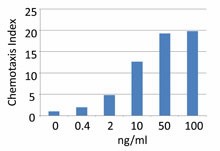- Regulatory Status
- RUO
- Other Names
- Eotaxin, eotaxin-1

-

Baf3-hCCR3 transfectants chemoattracted by mouse CCL11.
| Cat # | Size | Price | Quantity Check Availability | ||
|---|---|---|---|---|---|
| 582902 | 10 µg | $129.00 | |||
| 582904 | 25 µg | $229.00 | |||
| 582906 | 100 µg | $686.00 | |||
CCL11 is a member of the CC chemokine family and was originally identified as a chemoattractant for eosinophils. In response to allergens, CCL11, which participates in a variety of allergic diseases, promotes accumulation of eosinophils. In addition, CCL11 facilitates proliferation and metastasis of tumor cells expressing the CCL11 receptor, CCR3. CCL11 has been shown to induce angiogenic response by CCR3-positive microvascular endothelial cells.
Product Details
- Source
- Mouse CCL11, amino acids His24-Pro97 (Accession# NM_011330) was expressed in E. coli.
- Molecular Mass
- The 74 amino acid recombinant protein has a predicted molecular mass of approximately 8.4 kD. The DTT-reduced protein migrates at approximately 12 kD and non-reduced protein migrates at approximately 14 kD by SDS-PAGE. The N-terminal amino acid is Histidine.
- Purity
- >98%, as determined by Coomassie stained SDS-PAGE.
- Formulation
- 0.22 µm filtered protein solution is in PBS.
- Endotoxin Level
- Less than 0.01 ng per µg cytokine as determined by the LAL method.
- Concentration
- 10 and 25 µg sizes are bottled at 200 µg/mL. 100 µg size and larger sizes are lot-specific and bottled at the concentration indicated on the vial. To obtain lot-specific concentration and expiration, please enter the lot number in our Certificate of Analysis online tool.
- Storage & Handling
- Unopened vial can be stored between 2°C and 8°C for up to 2 weeks, at -20°C for up to six months, or at -70°C or colder until the expiration date. For maximum results, quick spin vial prior to opening. The protein can be aliquoted and stored at -20°C or colder. Stock solutions can also be prepared at 50 - 100 µg/mL in appropriate sterile buffer, carrier protein such as 0.2 - 1% BSA or HSA can be added when preparing the stock solution. Aliquots can be stored between 2°C and 8°C for up to one week and stored at -20°C or colder for up to 3 months. Avoid repeated freeze/thaw cycles.
- Activity
- Bioactivity was measured by its property to chemoattract Baf3-hCCR3 transfectants in a dose dependent manner.
- Application
-
Bioassay
- Application Notes
-
BioLegend carrier-free recombinant proteins provided in liquid format are shipped on blue-ice. Our comparison testing data indicates that when handled and stored as recommended, the liquid format has equal or better stability and shelf-life compared to commercially available lyophilized proteins after reconstitution. Our liquid proteins are verified in-house to maintain activity after shipping on blue ice and are backed by our 100% satisfaction guarantee. If you have any concerns, contact us at tech@biolegend.com.
-
Application References
(PubMed link indicates BioLegend citation) -
- Conroy DM, et al. 2001. Respir. Res. 2:150.
- Levina V, et al. 2009. Clin. Cancer Res. 15:2647.
- Salcedo R, et al. 2001. J. Immunol. 166:7571.
- Kaehler J, et al. 2006. J. Investig. Med. 54:446.
- Hadjicharalambous C, et al. 2004. J. Allergy Clin. Immunol. 113:657.
- Crump MP, et al. 1998. J. Biol. Chem. 273:22471.
Antigen Details
- Structure
- Chemokine
- Distribution
-
Epithelial cells, smooth muscle cells, dendritic cells, and fibroblasts
- Function
- CCL11 selectively recruits eosinophils through binding to the chemokine receptor CCR3 during allergic response. CCL11 production is upregulated in response to several proinflammatory cytokines, such as IL-4, IL-13, TNF-α, and IFN-α, produced by mast cells and Th2 lymphocytes. CCL11 has been reported to stimulate eosinophil release from bone marrow, resulting in an elevated level of circulating eosinophils.
- Interaction
- Eosinophils
- Ligand/Receptor
- CCR3
- Cell Type
- Dendritic cells
- Biology Area
- Angiogenesis, Cell Biology, Immunology, Neuroinflammation, Neuroscience
- Molecular Family
- Cytokines/Chemokines
- Gene ID
- 20292 View all products for this Gene ID
- UniProt
- View information about CCL11 on UniProt.org
